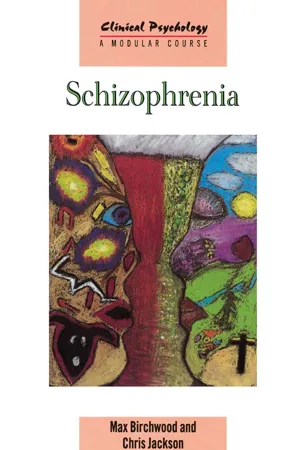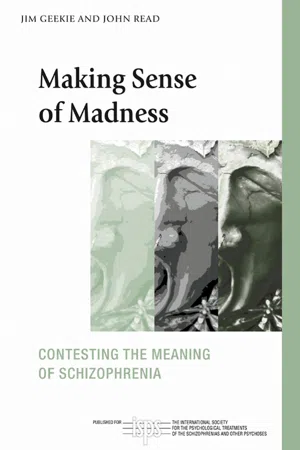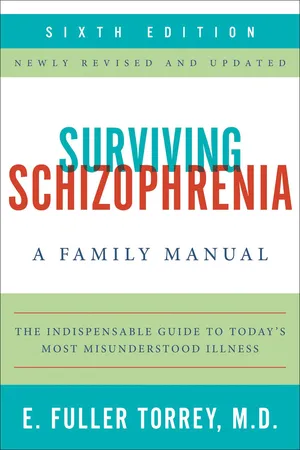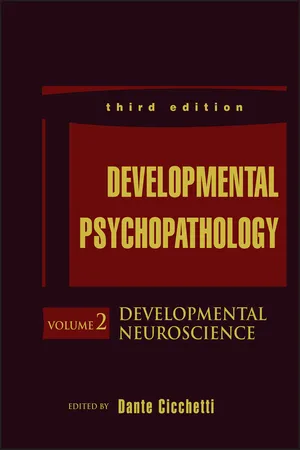Psychology
Theories of Schizophrenia
Theories of schizophrenia propose various explanations for the development and manifestation of this mental disorder. Biological theories emphasize genetic and neurobiological factors, while psychological theories focus on the role of early experiences and cognitive processes. Sociocultural theories consider the influence of social and cultural factors on the onset and course of schizophrenia. These theories contribute to our understanding of the complex nature of schizophrenia.
Written by Perlego with AI-assistance
Related key terms
10 Key excerpts on "Theories of Schizophrenia"
- eBook - ePub
- Max Birchwood, Chris Jackson(Authors)
- 2014(Publication Date)
- Psychology Press(Publisher)
Psychological aspects5In this chapter, three different psychological approaches to understanding schizophrenia are described: positive symptoms theories, neuropsychological theories, and theories of psychosis proneness.There have been a number of attempts to find a unified psychological theory to explain the complex array of symptoms and phenomena that defines schizophrenia (Arieti, 1955; Bateson, Jackson, Haley, & Weakland, 1956; Fromm-Reichman, 1948). By and large these have been unsuccessful; recently there has been a move away from all-encompassing psychological models and theories to those attempting to explain and understand the specific components or symptoms of schizophrenia and psychosis (Bentall, 1990; Costello, 1992). It is these theories that are the subject of this chapter.Psychological theories of positive symptoms
Delusions and hallucinations are perhaps the best known of all the symptoms of schizophrenia. Despite this and a century of study, these “positive” symptoms (see Chapter 1 ) remain poorly understood. It is important to understand that the positive symptoms of schizophrenia are played out in the mental arena where they are subjected to the vast array of processes common to all mental acts. It is therefore difficult to understand why psychological theories have been so slow to influence our understanding and treatment of delusions and hallucinations. This is now beginning to change, a situation that has encouraged the development of a number of psychological interventions that directly address the alleviation of distress associated with psychotic symptoms.Psychological theories and models of delusions
Delusions have until recently been subject to relatively little psychological research. This is surprising bearing in mind the wealth of studies looking at the formation and maintenance of ordinary beliefs and belief structures (Tesser, & Shaffer, 1990) and the central role that delusions play in diagnostic systems and more general definitions of madness (Winters, & Neale, 1983). For example, delusions have always been present in the legal definition of mental illness (Sims, 1991). - eBook - ePub
- Alan Carr(Author)
- 2003(Publication Date)
- Psychology Press(Publisher)
Chapter 4 Schizophrenia
- Introduction
- Clinical features
- Epidemiology and classification
- Etiological theories
- Biological theories
- Cognitive theories
- Social and family systems theories
- An integrative approach
- Schizophrenia and split personality
- Controversies
- Summary
- Further reading
Introduction
THE TERM SCHIZOPHRENIA REFERS to a Collection of Seriously debilitating conditions characterized chiefly by hallucinations, delusions and thought disorder. Hallucinations involve experiencing a sensation in the absence of an external stimulus. For example, with auditory hallucinations people report hearing voices that others cannot hear. Delusions are unfounded and culturally alien beliefs. For example, with persecutory delusions individuals may believe that a group of people are conspiring to harm them. Thought disorder refers to disorganized and illogical speech. When negative symptoms are present, the person may live a restricted lifestyle involving very little activity, and little social interaction with others and may express a very narrow range of emotions. People diagnosed with schizophrenia may also show negative symptoms such as restriction of activity, speech and affect.After considering the clinical features and epidemiology of schizophrenia, theoretical explanations of this condition will be presented later in the chapter. Each of these specific explanations has been developed within the context of one of three broad theories. These are the biological, cognitive-behavioural and family systems theories of psychological problems. In Chapter 6, these three broad theories of psychological problems, along with the psychodynamic model, are reviewed with reference to their main attributes, their contributions to our understanding and treatment of psychological problems, and their limitations.Case example
Julian was referred for assessment and advice by his GP. His parents were worried about him because he had been behaving strangely since returning to the family home after studying in London for a year. Julian had failed his exams and came home, he said, ‘to sort his head out’. He lacked concentration and his conversation was incoherent much of the time. Also his behaviour was erratic. He had gone jogging one morning the previous week and not returned. His parents had found him in his training shoes and running shorts 35 miles away later that day. He was exhausted and dehydrated. He explained that he was on his way to the car ferry to Holland on a secret mission. - eBook - ePub
Clinical Psychology
An Introduction
- Alan Carr(Author)
- 2012(Publication Date)
- Routledge(Publisher)
Modern research on schizophrenia has also been guided by two broad groups of theories. The first, in the tradition of Kraepelin, has been concerned largely with the role of biological factors in the aetiology and maintenance of the disorder. The second group of theories, in the tradition of Bleuler, has addressed the role of psychological factors in schizophrenia. In the following section, biological Theories of Schizophrenia and related research findings will be considered. This will be followed by a consideration of the stress-vulnerability or diathesis– stress approaches to conceptualizing schizophrenia and research findings of relevance to this position.Biological theories
Biological Theories of Schizophrenia point to the role of genetic and neurodevelopmental factors in rendering people vulnerable to the development of psychosis, and to the role of structural and functional brain abnormalities; dsysregulation of neurotransmitter systems; and sleep architecture and eye movement abnormalities in the aetiology of schizophrenia. There is considerable support for biological theories from neuroimaging, pharmacological, psychophysiological and other neurobiological studies, although current knowledge of these abnormalities is incomplete (Bora et al., 2011; Downar & Kapur, 2008; Eyler, 2008; Fatemi & Folsom, 2009; Glatt, 2008; Harrison, 2009; Hollis, 2008; Keshavan et al., 2008; Murray & Castle, 2009; Ritsner & Gottesman, 2011; Stewart & Davis, 2008). However, there is a consensus about certain aspects of the neurobiology of schizophrenia, which will be presented below.Genetics
The genetic hypothesis proposes that schizophrenia arises primarily from an inherited vulnerability to psychosis. Results of twin, adoption and family studies show that a predisposition to schizophrenia spectrum disorders is genetically transmitted. Schizophrenia is about 80% heritable (Glatt, 2008; Sullivan et al., 2003). The lifetime risk for developing schizophrenia is proportional to the number of shared genes. For monozygotic twins the risk is 48%; for dizygotic twins the risk is 17%; for children of an affected parent the risk is 13%; for grandchildren the risk is 5%; and for members of the general population the risk is about 1% (Ritsner & Gottesman, 2011). It is also probable that the vulnerability is polygenetically transmitted, since the results of family studies cannot easily be accounted for by simpler models of genetic transmission. - eBook - ePub
Making Sense of Madness
Contesting the Meaning of Schizophrenia
- Jim Geekie, John Read(Authors)
- 2009(Publication Date)
- Routledge(Publisher)
While our focus in this section has been mostly on sexual abuse as a possible causal contributor to schizophrenia, this is not the only life event which has been implicated in schizophrenia. Other life events which have been found to be associated with schizophrenia include physical abuse and bullying (Janssen et al. 2004); poverty (Faris and Dunham 1939; Harrison et al. 2001); belonging to an ethnic minority (Hutchison et al. 1996); experiences of racial discrimination (Janssen et al. 2003); recent stressful experiences (Birley and Brown 1970). Other variables which have been considered important in understanding schizophrenia include the notion that urban environment may contribute to psychosis (van Os 2004). Sundquist et al. (2004) discuss evidence consistent with this view and consider the possibility that factors such as poor social networks and lack of support may contribute to the condition.The theories considered so far in this chapter have developed largely from clinical disciplines, whether they be primarily medical in their orientation, or more inclined to a psychotherapeutic perspective. However, this does not exhaust the range of professional and scientific theories that have been proposed as explanations of what schizophrenia is. Other disciplines have also investigated schizophrenia, and come up with quite different conceptualizations. We will now consider some of these theories.Sociological and anthropological Theories of Schizophrenia
The theories discussed so far (with the exception of communication and family theories) have in common that they take a largely individualistic approach to schizophrenia. By this, we mean that they take as their starting point the assumption that schizophrenia can be understood by looking to the individual who receives this diagnosis, and identifying what it is that is unusual about this individual that explains how it is that he or she has developed this complaint. In contrast, sociological and anthropological approaches tend to adopt quite a different starting position, in that their focus is much more on the social context within which a diagnosis of schizophrenia is made. As such, the social and cultural practices involved in the process of identifying someone as ‘deviant’, and then labelling the person as mentally ill, are given greater prominence in sociological and anthropological accounts of schizophrenia. - Phil Gorman(Author)
- 2020(Publication Date)
- Routledge(Publisher)
Chapter 4Spec checkPsychological explanations for schizophrenia
Psychological explanations for schizophrenia: family dysfunction and cognitive explanations, including dysfunctional thought processing.AO1 (Knowledge and understanding): What are the psychological explanations for schizophrenia?
Psychological influences on mental health
In Chapter 3 , the World Health Organisation (WHO) definition for mental disorders suggested a clear role for the mind and behaviour, rather than for biological factors. These psychological factors include a variety of influences, ranging from specific environmental factors that have a social influence on us and alter our behaviour to factors that are directly related to mental processes and affect our understanding of the world around us. All these factors can affect our normal daily lives through their influence on our thoughts and feelings, which may sometimes beadaptivebut at times can bemaladaptivetoo.Psychological influences focus on the factors that have caused a person’s mind and behaviour to develop in the way that it has, rather than the biological influences on their brain and nervous system looked at in Chapter 3 . These psychological influences are likely to be those that relate to a person’s upbringing and their treatment by those around them, e.g. by their parents. In the past, psychologists have gone as far as to blame the mother for the way that she has brought up her children, specifically with the notion of theschizophrenogenic mother- eBook - ePub
- E. Fuller Torrey(Author)
- 2019(Publication Date)
- Harper Perennial(Publisher)
They acknowledge being firmly opposed to the biomedical model of schizophrenia, believing rather that the disease has predominantly psychological, not medical, roots. Such overt bias impairs their credibility in interpreting the studies that have been carried out. Obsolete Theories As knowledge evolves in every field of scientific inquiry, new theories arise to explain these observations. At the same time, older theories that no longer fit the facts are set aside and eventually discarded. All areas of science have dusty shelves full of discarded theories, and schizophrenia research is no exception. Some of the more unusual prominent theories are as follows: Freudian Theory: For the first half of the twentieth century, Freud’s psychoanalytic theories were prominent in the United States. Freud taught that bad mothering causes schizophrenia. Freud himself knew almost nothing about the disease and avoided seeing patients who had it. In a 1907 letter, he acknowledged: “I seldom see dements [dementia praecox, or schizophrenia] and hardly ever see other severe types of psychosis.” Four years later, he wrote: “I do not like these patients [with schizophrenia]. . .. I feel them to be so far distant from me and from everything human.” Any mental health professional who still professes Freudian beliefs about schizophrenia should be regarded as incompetent. Bad Families: In addition to Freudian theories about bad mothers, in the 1950s a series of theories about bad families was put forward to explain the cause of schizophrenia. Individuals associated with these theories included Theodore Lidz, Gregory Bateson, and Don Jackson. These family interaction theories were tested in controlled studies and found to be wrong, and have been discarded - eBook - ePub
- JOHN P CUTTING, Anthony David(Authors)
- 2019(Publication Date)
- Psychology Press(Publisher)
1 The Neuropsychology of Schizophrenia—Introduction and OverviewAnthony S. David Department of Psychological Medicine, King’s College Hospital and the Institute of Psychiatry, London. John C. Cutting Institute of Psychiatry, LondonThe idea that there is a “neuropsychology of schizophrenia” is of relatively recent origin. Indeed, the term “neuropsychology” itself only dates back three or four decades. The concept to which it refers, however, is far from new.The thrust of Kraepelin’s and most of his fin de siècle German contemporaries’ research into schizophrenia was towards elucidating the biological basis of the condition, which included questions such as whether particular parts of the brain were damaged more than others. The spate of higher-order neurological deficits uncovered in the last half of the nineteenth century—aphasia, agnosia, apraxia, alexia, etc.—led many psychiatrists to suppose that schizophrenia, like these other conditions, would turn out to have a specific link with some damaged brain site, e.g. Broca’s aphasia with a lesion in the left second and third frontal gyri. A minority of more neurologically-orientated physicians (e.g. Wernicke and Kleist) did, in fact, develop just such a detailed system (without any real neurobiological evidence, however). Kraepelin, although committed to this approach, was rigorous enough to realise that he could not as yet justify such schemes.Bleuler’s incorporation of Freud’s and Jung’s psychodynamic explanations of psychiatric phenomena paved the way for a multitude of non-neuropsychological approaches—psychodynamic, social, existential, behavioural, and cognitive models—which persisted as the mainstream of thinking for over 70 years. All these merely adopted some current psychological model of mind (or non-mind in the case of behavioural) and schizophrenia was slotted into these in the most plausible way possible. - eBook - ePub
Psychopathology
History, Diagnosis, and Empirical Foundations
- W. Edward Craighead, David J. Miklowitz, Linda W. Craighead(Authors)
- 2017(Publication Date)
- Wiley(Publisher)
Chapter 10Schizophrenia and the Psychosis SpectrumArthur T. Ryan Hanan D. Trotman Vijay A. Mittal Kevin D. Tessner Elaine F. WalkerI can't find the words to describe it. Schizophrenia is like a disconnect. My thoughts and my feelings are not connected. I'm not connected with other people. I don't understand them and they don't understand me. It is like life is just passing me by, and it is out of my control. My mind is out of my control and it is frightening.—Schizophrenia patientThe preceding words are from a man in his 40s who was diagnosed with schizophrenia during his 20s. Schizophrenia is a brain disorder whose symptoms typically show up by young adulthood and continue as a chronic condition, albeit waxing and waning over time. It has affected nearly every aspect of this man's life, including making friends, getting married, and holding down a job. This chapter will attempt to explain how this complex and often misunderstood illness can have such pervasive effects upon those who suffer from it.Schizophrenia falls into the broader category of psychotic disorders. The defining symptoms of psychotic disorders involve a disconnect from reality. Psychotic symptoms include hallucinations (perceiving things that aren't there), delusions (strange fixed beliefs that are not amenable to change despite exposure to contradictory evidence), disorganized and illogical thinking, and bizarre behavior. Schizophrenia is probably the disorder most closely associated with psychotic symptoms in the minds of clinicians and the general public alike. Other psychotic disorders include bipolar I disorder, major depressive disorder with psychotic features, and delusional disorder. As this chapter will go on to explain, however, schizophrenia's psychotic symptoms are just one component of this complex and often misunderstood disease.Symptoms and Diagnostic Criteria
The modern conceptualization of schizophrenia divides its symptoms into three major categories. The names of some of these categories may be confusing at first, but once one understands the underlying logic, the categories can help to sensibly organize schizophrenia's wide array of symptoms. The three categories are positive symptoms, negative symptoms, and cognitive symptoms. - eBook - ePub
- E. Fuller Torrey(Author)
- 2014(Publication Date)
- Harper Paperbacks(Publisher)
Beginning in the last quarter of the twentieth century, research on schizophrenia finally got back on track, as was noted in the last chapter. The present challenge is to synthesize the rapidly accumulating data into a coherent theory and then prove them to be correct. One is reminded of Edna St. Vincent Millay’s sonnet that described “a meteoric shower of facts” that “lie unquestioned, uncombined”:Wisdom enough to leech of our ill Is daily spun, but there exists no loom To weave it into fabric.A major impediment to weaving the facts about schizophrenia into a coherent theory is the question of heterogeneity: Is schizophrenia one disease or many diseases? Most researchers have assumed the latter, but that is not established as fact. A case can be made for the opposite approach—that most cases of schizophrenia may turn out to have a single major cause. Dr. Lewis Thomas pointed out that syphilis, tuberculosis, and pernicious anemia were all conditions with a bewildering variety of manifestations that few scientists thought could constitute a single illness, yet in each case a single cause (spirochete, tubercle bacillus, and vitamin deficiency) was eventually found to be the primary cause. That this may be true for schizophrenia (and possibly for manic-depressive illness as well) is certainly possible.This chapter will summarize theories about the cause of schizophrenia, including theories that are currently at the center of research as well as those now considered to be obsolete. The reader should keep in mind that many of these theories are not mutually exclusive, and the final answer may involve some combination of them. The reader should also be aware that my own research is on infectious causes of schizophrenia, so I may not be completely objective regarding competing theories.Genetic TheoriesGenetic theories regarding schizophrenia have been prominent since the 1960s, when biological researchers promoted them as an alternative to psychoanalytic theories. Genetic theories continue to be accepted; as recently as 2008 a group of respected genetics researchers claimed that “the point estimate of heritability in liability to schizophrenia was 81 percent.” Critics, including me, believe that this estimate is wildly inflated. - Dante Cicchetti(Author)
- 2016(Publication Date)
- Wiley(Publisher)
Thus, current models offer promising hypotheses regarding mechanisms by which processes associated with postpubertal brain development might interact with earlier compromises of the brain in predisposing to schizophrenia. Nevertheless, theories as to why adolescence represents a time of increased risk for schizophrenia onset remain speculative. It may be that heterogeneity in the course and outcome of schizophrenia is a function of the interaction of early brain pathology with normal or abnormal developmental factors occurring throughout life, up until the time when the illness commences (Pantelis, Yucel, et al., 2003). Findings of accelerated gray matter loss proximal to the time of illness onset may reflect aberrant maturational processes during adolescence, or may reflect an interaction of early neurodevelopmental anomalies with adolescent maturational processes. Whatever the cause, recent studies that follow patients longitudinally through the prodromal phase into the first episode of illness do provide evidence for progressive structural changes during this time period. The role of later environmental stressors, and how they may impact upon an already vulnerable individual, warrants further investigation in both naturalistic human studies and via experimental animal models.Summary and Conclusions
According to the original neurodevelopmental hypothesis of schizophrenia, the disorder results from a set of basic biological errors that occur early in life and lead to a combination of structural, functional, or biochemical anomalies in the developing brain. This model of schizophrenia has been highly influential, and has moved the field substantially forward by focusing attention on early developmental deviation in individuals who develop the illness in adulthood. Specifically, in the area of epidemiology, this model has led to the investigation of early signs of functional compromise in individuals destined to develop schizophrenia in adulthood, and the interaction of specific obstetric complications with genetic factors in the etiology of psychotic illness. Convergent evidence from neuropathological investigations indicates patterns of neuronal displacement consistent with a neurodevelopmental origin.
Learn about this page
Index pages curate the most relevant extracts from our library of academic textbooks. They’ve been created using an in-house natural language model (NLM), each adding context and meaning to key research topics.









